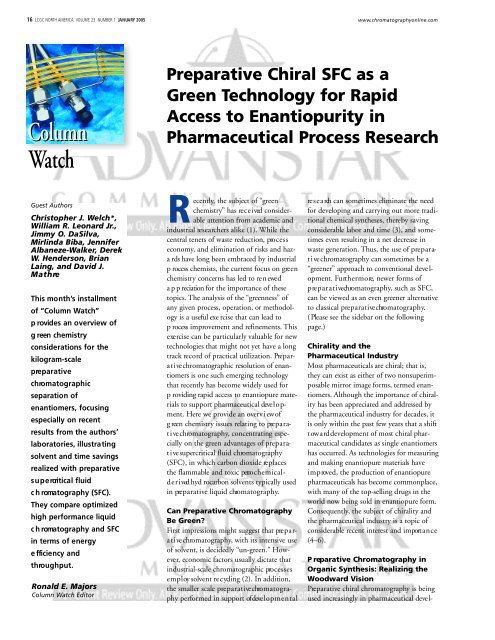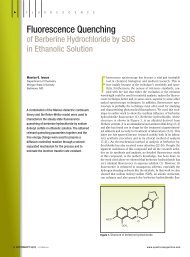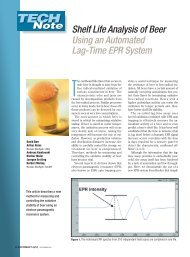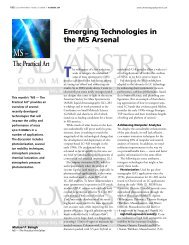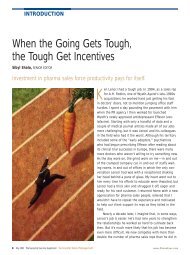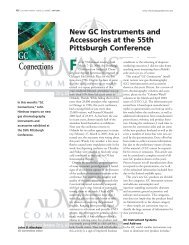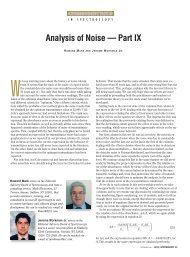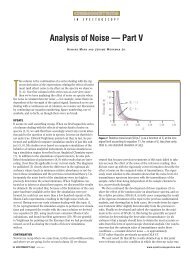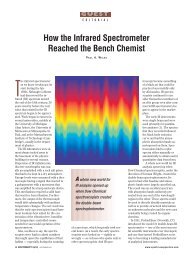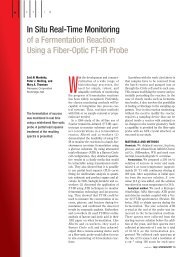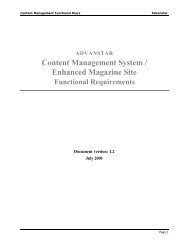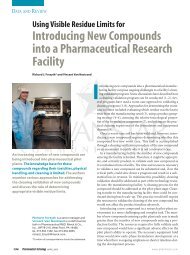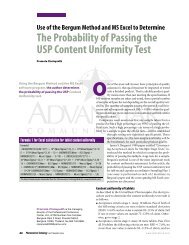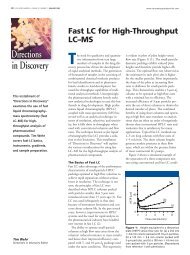Column Wa t c h C o l u m n - Pharmaceutical Technology
Column Wa t c h C o l u m n - Pharmaceutical Technology
Column Wa t c h C o l u m n - Pharmaceutical Technology
Create successful ePaper yourself
Turn your PDF publications into a flip-book with our unique Google optimized e-Paper software.
1 6 LCGC NORTH AMERICA VOLUME 23 NUMBER 1 JA N UA RY 2005 w w w. c h r o m a t o g r a p h y o n l i n e . c o m<br />
C <strong>Column</strong> o l u m n<br />
<strong>Wa</strong> t c h<br />
P reparative Chiral SFC as a<br />
G reen <strong>Technology</strong> for Rapid<br />
Access to Enantiopurity in<br />
<strong>Pharmaceutical</strong> Process Researc h<br />
Guest Authors<br />
Christopher J. We l c h * ,<br />
William R. Leonard Jr. ,<br />
Jimmy O. DaSilva,<br />
Mirlinda Biba, Jennifer<br />
A l b a n e z e - <strong>Wa</strong> l k e r, Dere k<br />
W. Henderson, Brian<br />
Laing, and David J.<br />
M a t h re<br />
This month’s installment<br />
of “<strong>Column</strong> <strong>Wa</strong> t c h ”<br />
p rovides an overview of<br />
g reen chemistry<br />
considerations for the<br />
k i l o g r a m - s c a l e<br />
p re p a r a t i v e<br />
c h ro m a t o g r a p h i c<br />
separation of<br />
enantiomers, focusing<br />
especially on re c e n t<br />
results from the authors’<br />
laboratories, illustrating<br />
solvent and time savings<br />
realized with pre p a r a t i v e<br />
s u p e rcritical fluid<br />
c h romatography (SFC).<br />
They compare optimized<br />
high performance liquid<br />
c h romatography and SFC<br />
in terms of energy<br />
e fficiency and<br />
t h ro u g h p u t .<br />
Ronald E. Majors<br />
<strong>Column</strong> <strong>Wa</strong>tch Editor<br />
Re c e n t l y, the subject of “g re e n<br />
c h e m i s t ry” has re c e i ved considerable<br />
attention from academic and<br />
industrial re s e a rchers alike (1). While the<br />
central tenets of waste reduction, pro c e s s<br />
e c o n o m y, and elimination of risks and haza<br />
rds have long been embraced by industrial<br />
p rocess chemists, the current focus on gre e n<br />
c h e m i s t ry concerns has led to re n ewe d<br />
a p p reciation for the importance of these<br />
topics. The analysis of the “g re e n n e s s” of<br />
any given process, operation, or methodology<br />
is a useful exe rcise that can lead to<br />
p rocess improvement and refinements. T h i s<br />
e xe rcise can be particularly valuable for new<br />
technologies that might not yet have a long<br />
track re c o rd of practical utilization. Pre p a r-<br />
a t i ve chromatographic resolution of enantiomers<br />
is one such emerging technology<br />
that recently has become widely used for<br />
p roviding rapid access to enantiopure materials<br />
to support pharmaceutical deve l o p-<br />
ment. He re we provide an ove rv i ew of<br />
g reen chemistry issues relating to pre p a r a-<br />
t i ve chro m a t o g r a p h y, concentrating especially<br />
on the green advantages of pre p a r a-<br />
t i ve supercritical fluid chro m a t o g r a p h y<br />
(SFC), in which carbon dioxide re p l a c e s<br />
the flammable and toxic petro c h e m i c a l -<br />
d e r i ved hyd rocarbon solvents typically used<br />
in pre p a r a t i ve liquid chro m a t o g r a p h y.<br />
Can Preparative Chro m a t o g r a p h y<br />
Be Gre e n ?<br />
First impressions might suggest that pre p a r-<br />
a t i ve chro m a t o g r a p h y, with its intensive use<br />
of solvent, is decidedly “u n - g reen.” Howe<br />
ve r, economic factors usually dictate that<br />
industrial-scale chromatographic pro c e s s e s<br />
e m p l oy solvent re c ycling (2). In addition,<br />
the smaller scale pre p a r a t i ve chro m a t o g r a-<br />
phy performed in support of deve l o p m e n t a l<br />
re s e a rch can sometimes eliminate the need<br />
for developing and carrying out more traditional<br />
chemical syntheses, there by saving<br />
considerable labor and time (3), and sometimes<br />
even resulting in a net decrease in<br />
waste generation. Thus, the use of pre p a r a-<br />
t i ve chromatography can sometimes be a<br />
“g re e n e r” approach to conventional deve l-<br />
opment. Fu rt h e r m o re, newer forms of<br />
p re p a r a t i ve chro m a t o g r a p h y, such as SFC,<br />
can be viewed as an even greener alternative<br />
to classical pre p a r a t i ve chro m a t o g r a p h y.<br />
( Please see the sidebar on the follow i n g<br />
p a g e . )<br />
Chirality and the<br />
<strong>Pharmaceutical</strong> Industry<br />
Most pharmaceuticals are chiral; that is,<br />
they can exist as either of two nonsuperimposable<br />
mirror image forms, termed enantiomers.<br />
Although the importance of chirality<br />
has been appreciated and addressed by<br />
the pharmaceutical industry for decades, it<br />
is only within the past few years that a shift<br />
t ow a rd development of most chiral pharmaceutical<br />
candidates as single enantiomers<br />
has occurred. As technologies for measuring<br />
and making enantiopure materials have<br />
i m p roved, the production of enantiopure<br />
pharmaceuticals has become commonplace,<br />
with many of the top-selling drugs in the<br />
world now being sold in enantiopure form.<br />
C o n s e q u e n t l y, the subject of chirality and<br />
the pharmaceutical industry is a topic of<br />
considerable recent interest and import a n c e<br />
( 4 – 6 ) .<br />
P reparative Chromatography in<br />
Organic Synthesis: Realizing the<br />
Wo o d w a rd Vi s i o n<br />
Pre p a r a t i ve chiral chromatography is being<br />
used increasingly in pharmaceutical deve l-
1 8 LCGC NORTH AMERICA VOLUME 23 NUMBER 1 JA N UA RY 2005<br />
12 Principles of<br />
G reen Chemistry<br />
(From reference 1)<br />
1.Prevention: It is better to prevent waste<br />
than to treat or clean up waste after it has<br />
been created.<br />
2. Atom Economy: Synthetic methods<br />
should be designed to maximize the incorporation<br />
of all materials used in the<br />
process into the final product.<br />
3. Less Hazardous Chemical Syntheses:<br />
Wherever practicable, synthetic methods<br />
should be designed to use and generate<br />
substances that possess little or no toxicity<br />
to human health and the environment.<br />
4. Designing Safer Chemicals: Chemical<br />
products should be designed to eff e c t<br />
their desired function while minimizing<br />
their toxicity.<br />
5. Safer Solvents and Auxiliaries: The use<br />
of auxiliary substances (for example, solvents,<br />
separation agents, and so forth)<br />
should be made unnecessary wherever<br />
possible and innocuous when used.<br />
6. Design for Energy Eff i c i e n c y : E n e r g y<br />
requirements of chemical processes should<br />
be recognized for their environmental and<br />
economic impacts and should be minimized.<br />
If possible, synthetic methods<br />
should be conducted at ambient temperature<br />
and pressure.<br />
7. Use of Renewable Feedstocks: A raw<br />
material or feedstock should be renewable<br />
rather than depleting whenever technically<br />
and economically practicable.<br />
8. Reduce Derivatives: Unnecessary derivatization<br />
(use of blocking groups, protection–deprotection,<br />
temporary modification<br />
of physical–chemical processes)<br />
should be minimized or avoided if possible,<br />
because such steps require additional<br />
reagents and can generate waste.<br />
9. Catalysis: Catalytic reagents (as selective<br />
as possible) are superior to stoichiometric<br />
r e a g e n t s .<br />
10. Design for Degradation: Chemical<br />
products should be designed so that at<br />
the end of their function they break down<br />
into innocuous degradation products and<br />
do not persist in the environment.<br />
11. Real-time Analysis for Pollution Prev<br />
e n t i o n : Analytical methodologies need to<br />
be further developed to allow for realtime,<br />
in-process monitoring and control<br />
before the formation of hazardous subs<br />
t a n c e s .<br />
12. Inherently Safer Chemistry for Accident<br />
Prevention: Substances and the form<br />
of a substance used in a chemical process<br />
should be chosen to minimize the potential<br />
for chemical accidents.<br />
opment for rapidly accessing enantiomerically<br />
pure materials on the kilogram or eve n<br />
larger scale (7). Pre p a r a t i ve high perf o r m-<br />
ance liquid chromatography (HPLC) is<br />
used most frequently for the kilogram-scale<br />
separations needed to support deve l o p-<br />
ment, with simulated moving bed chromatography<br />
(SMB) or other multicolumn<br />
c h romatography approaches pre d o m i n a t i n g<br />
at industrial scale (greater than hundreds of<br />
kilograms) (8–12).The integration of<br />
p re p a r a t i ve chiral chromatography into<br />
organic synthesis remains a rapidly evo l v i n g<br />
field, and new stratagems for merging the<br />
two fields are being created. Ne ve rt h e l e s s ,<br />
the incorporation of pre p a r a t i ve HPLC<br />
into organic synthesis is by no means a new<br />
phenomenon. R.B. Wo o d w a rd, perhaps the<br />
most famous synthetic chemist of the twe n-<br />
tieth century, was an early advocate of<br />
p re p a r a t i ve HPLC, declaring in 1973 (2)<br />
that “The power of these high pre s s u re liquid<br />
chromatographic methods hardly can<br />
be imagined by the chemist who has not<br />
had experience with them; they re p re s e n t<br />
re l a t i vely simple instrumentation and I am<br />
c e rtain that they will be indispensable in<br />
the laboratory of eve ry organic chemist in<br />
the near future.” (13)<br />
In t e re s t i n g l y, it is only within the last few<br />
years that Wo o d w a rd’s prediction of the<br />
w i d e s p read adoption of pre p a r a t i ve HPLC<br />
as an enabling technique for organic synthesis<br />
has begun to be borne out. In re c e n t<br />
years, there has been a growing appre c i a t i o n<br />
w w w. c h r o m a t o g r a p h y o n l i n e . c o m<br />
F i g u re 1: A typical case illustrating the preparative chromatographic enantioseparation of a<br />
development intermediate on the kilogram scale. <strong>Column</strong>: 25 cm 3 11 cm DAC Chiralpak AD; flow<br />
rate: 600 mL/min; mobile phase: 25% ethanol–heptane; detection: UV absorbance at 285 nm; injection:<br />
150 mL racemate at 83 mg/mL in mobile phase.<br />
of the value that pre p a r a t i ve chro m a t o g r a-<br />
phy can bring to organic synthesis, and the<br />
technique is now used broadly within the<br />
pharmaceutical and fine chemical<br />
industries.<br />
G reen Aspects of Pre p a r a t i v e<br />
C h romatography: <strong>Wa</strong>ste Reduction<br />
Se veral of the 12 principles of green chemi<br />
s t ry, outlined in the sidebar, are especially<br />
applicable to the field of pre p a r a t i ve chrom<br />
a t o g r a p h y. Process chemists have long<br />
been concerned with the topics of waste<br />
p re vention, atom economy, and the use of<br />
i n h e rently safe chemistry for accident prevention<br />
(principles 1, 2, and 12). Also,<br />
p re p a r a t i ve chromatography is concerned<br />
especially with the issue of safer solve n t s<br />
and auxiliaries (principle 5).<br />
Elimination of waste is always a key<br />
g reen chemistry concern, and an import a n t<br />
factor in any separation of enantiomers<br />
(that is, resolution). Whether using classical<br />
resolution via diastereomeric salt formation,<br />
enzymatic kinetic resolution, pre f e re n t i a l<br />
c rystallization, or chro m a t o g r a p h y, all re s o-<br />
lutions suffer, in theory, from the fundamental<br />
drawback of being inherently wasteful,<br />
as at most, only half of the material is<br />
re c ove red (the half corresponding the<br />
d e s i red enantiomer, the other half being<br />
“w a s t e”). Despite this seemingly gross violation<br />
of the principles of atom economy<br />
(14), racemization and re c ycling of the<br />
u n d e s i red enantiomer sometimes is possi-
2 2 LCGC NORTH AMERICA VOLUME 23 NUMBER 1 JA N UA RY 2005 w w w. c h r o m a t o g r a p h y o n l i n e . c o m<br />
F i g u re 2: Representative chromatograms illustrating (a) a single injection and (b) repetitive overlapped injections for the semipreparative SFC resolution<br />
of the enantiomers of a developmental compound. <strong>Column</strong>: 25 cm 3 2 cm Chiralcel OD; mobile phase: 32% (25 mM isobutylamine in<br />
methanol)–carbon dioxide; flow rate: 50 mL/min; outlet pressure: 100 bar; detection: UV absorbance at 280 nm; injection: 2 mL at 160 mg/mL.<br />
ble, enabling higher yield and reduction of<br />
waste. Coupling of such resolution and isomerization<br />
approaches can lead to tru l y<br />
i m p re s s i ve processes for generating enantiopurity<br />
(15), and such approaches have<br />
long been a mainstay of successful industrial-scale<br />
synthesis of enantiopure materials.<br />
The possibility of racemizing and re c y-<br />
cling the undesired enantiomer from a<br />
c h romatographic resolution is becoming a<br />
routine consideration in development, and<br />
when possible, such racemization–re c yc l i n g<br />
a p p roaches can have a significant impact on<br />
p rocess economy. T h e re f o re, inve s t i g a t i o n<br />
of racemization is an important consideration<br />
when deciding where in a synthesis a<br />
resolution should be placed.<br />
G reen Aspects of Pre p a r a t i v e<br />
C h romatography: Safer Solvents<br />
The green chemistry principle of using safer<br />
s o l vents and auxiliaries is critically important<br />
to the area of pre p a r a t i ve chro m a t o g r a-<br />
p h y. A typical pre p a r a t i ve HPLC re s o l u t i o n<br />
is illustrated in Fi g u re 1. In this separation,<br />
the desired component is the second eluted<br />
e n a n t i o m e r, which is collected with . 9 8 %<br />
enantiomeric excess and 80% re c ove ry.<br />
Re p e t i t i ve injection under these conditions<br />
was used to obtain 1.1 kg of desired enantiomer<br />
with 55 h of instrument time and<br />
with the utilization of about 2000 L of solvent,<br />
840 L of which was evaporated for an<br />
overall productivity of about 0.3 kkd (kilograms<br />
of purified enantiomer per kilogram<br />
of stationary phase per 24-h day). Although<br />
the conditions of this pre p a r a t i ve separation<br />
could be improved to afford improved productivity<br />
and re c ove ry, it is important to<br />
re a l i ze that accessing more than a kilogram<br />
of enantiopure product in only 55 h means<br />
the chromatographic approach can be performed<br />
with only a small fraction of the<br />
cost that would be re q u i red to obtain this<br />
same result by conventional methods. It is<br />
this economic reality that underlies the<br />
w i d e s p read adoption of pre p a r a t i ve chromatography<br />
within the pharmaceutical and<br />
fine chemical industries.<br />
Productivity is the key metric for pre p a r-<br />
a t i ve chiral chromatography and is give n<br />
with units of kkd. In early deve l o p m e n t ,<br />
c h romatographic productivity is often poor<br />
(0.1 kkd or even lower) with a good separation<br />
having a productivity in the range of 1<br />
kkd. A truly re m a rkable separation might<br />
h a ve a productivity greater than 10 kkd.<br />
From the example shown in Fi g u re 1, it can<br />
be appreciated that a large amount of solvent<br />
(2000 L) is re q u i red for perf o r m i n g<br />
this re l a t i vely unpro d u c t i ve separation, and<br />
while this solvent can in principle be re c y-<br />
cled, this typically is not done during early<br />
d e velopment re s e a rch. In addition to being<br />
s o m ewhat wasteful of re s o u rces, the use of<br />
so much solvent re q u i res specialized equipment<br />
and work environment, and dictates<br />
that a ve ry large volume of solvent must be<br />
e vaporated to re c over the desired material.<br />
The use of SFC for pre p a r a t i ve enantioseparation<br />
has enjoyed considerable<br />
recent attention (16–19) and is the method<br />
of first choice in our own laboratories. In<br />
this technique, supercritical or subcritical<br />
carbon dioxide replaces flammable and<br />
t oxic petro c h e m i c a l - d e r i ved hyd ro c a r b o n s ,<br />
resulting in reduction in solvent utilization<br />
by as much as 90% or more. The re s u l t i n g<br />
d e c rease in solvent use and waste generation<br />
offers a green advantage with an economic<br />
bonus that makes pre p a r a t i ve SFC<br />
especially attractive. Fu rt h e r m o re, with<br />
p re p a r a t i ve SFC, the product is re c ove re d<br />
in a more concentrated form re l a t i ve to<br />
H P LC, greatly reducing the amount of solvent<br />
that must be evaporated and re s u l t i n g<br />
in considerable savings in labor, time, and<br />
energy costs. Fi n a l l y, because of the low viscosity<br />
of the supercritical fluid eluent, separations<br />
can be conducted at flow rates that<br />
would be impossible with liquid solve n t s ,<br />
an advantage that can contribute to the<br />
often higher productivity of pre p a r a t i ve<br />
SFC enantioseparations re l a t i ve to HPLC<br />
methods. Cu m u l a t i ve l y, these adva n t a g e s<br />
make pre p a r a t i ve SFC enantioseparation an
2 4 LCGC NORTH AMERICA VOLUME 23 NUMBER 1 JA N UA RY 2005 w w w. c h r o m a t o g r a p h y o n l i n e . c o m<br />
F i g u re 3: Semipreparative SFC used for preparative separation of enantiomers. More than 200 g of a racemate was resolved in ;2700 injections,<br />
with ;60 h of instrument time. Chiralcel OF (Chiral Technologies) chromatograms showing (top) three repeat injection cycles and (bottom) a block<br />
of 99 injections. Productivity 5 0.8 kkd. <strong>Column</strong>: 25 cm 3 2 cm Chiralcel OF; 15% isopropanol–carbon dioxide; flow rate: 50 mL/min; outlet pressure:<br />
100 bar; detection: UV absorbance at 270 nm; injection: 500 mL at 150 mg/mL in isopropanol.<br />
a t t r a c t i ve and potentially greener addition<br />
to conventional HPLC approaches, and a<br />
technique with a promising future.<br />
G reen Aspects of Pre p a r a t i v e<br />
C h romatography: Energy<br />
E ff i c i e n c y<br />
Energy efficiency is another matter of considerable<br />
importance in large-scale chromatographic<br />
separations. Pre p a r a t i ve liquid<br />
c h romatography using automated fraction<br />
collection and solvent re c ycling via continuous<br />
distillation was known by the early<br />
1970s (20) and is increasingly used today.<br />
So l vent evaporation can be highly energy<br />
i n t e n s i ve, to the point that the energy<br />
re q u i rements for evaporation can become<br />
the dominant cost in an industrial-scale<br />
c h romatographic process. An SFC system<br />
re q u i res additional heating and cooling not<br />
re q u i red for HPLC systems, and thus, additional<br />
energy demands. Incoming carbon<br />
d i oxide eluent must be cooled to a liquid so<br />
as to allow effective pumping, and immediately<br />
following pumping, the temperature<br />
of the carbon dioxide stream typically is<br />
raised to about 35 °C before it enters the<br />
column. Eva p o r a t i ve cooling resulting fro m<br />
d e p ressurization at the postcolumn outlet<br />
s t ream of the SFC instrument must be<br />
counteracted by more heating, which can<br />
be fairly energy intensive. Fi n a l l y, re c yc l i n g<br />
carbon dioxide re q u i res additional cooling<br />
of carbon dioxide gas from the outlet<br />
s t ream so as to condense into a liquid for<br />
reuse. In total, an operating SFC unit is<br />
heated and cooled simultaneously at seve r a l<br />
locations, and although in principle some<br />
o p p o rtunities exist for reduction of energy<br />
consumption via heat exchange, this typically<br />
is not done on laboratory-scale instruments.<br />
In comparison, HPLC re q u i res no<br />
heating and cooling for operation, raising<br />
the question of the energy utilization of<br />
SFC re l a t i ve to HPLC. The power demand<br />
is less than 5 kW for a pre p a r a t i ve SFC system<br />
pumping 350 g/min of a 10%<br />
methanol–carbon dioxide eluent mixture at<br />
a temperature of 35 °C and an outlet pre s-<br />
s u re of 100 bar with carbon dioxide re c y-<br />
cling. Power re q u i rements for continuous<br />
s o l vent evaporation (heating and cooling)<br />
to keep pace with such a unit would be on<br />
the order of 2 kW, whereas power re q u i rements<br />
to keep pace with solvent eva p o r a-<br />
tion for a comparable HPLC unit (assuming<br />
103 s o l vent utilization) would be on<br />
the order of 20 kW. Thus, it can be seen<br />
that even in terms of energy utilization,<br />
SFC is greener than HPLC, because of the<br />
high energy cost of solvent evaporation. As<br />
later examples will show, this SFC adva n-<br />
tage can be even more pronounced because<br />
of additional solvent reductions afforded by<br />
the oftentimes improved productivity of<br />
SFC versus HPLC.<br />
G reen Aspects of Pre p a r a t i v e<br />
C h romatography: Te m p e r a t u re ,<br />
P re s s u re, and Carbon Dioxide as a<br />
G reenhouse Gas<br />
In addition to the fundamental point of<br />
designing for energy efficiency, green chemi<br />
s t ry principle 6 (design for energy efficiency)<br />
clearly states, “If possible, synthetic<br />
methods should be conducted at ambient<br />
t e m p e r a t u re and pre s s u re.” While it can be<br />
argued that a separation method is not a<br />
synthesis method, the intent of using<br />
e x t remes of temperature and pre s s u re only<br />
when warranted is clearly implied. T h u s ,<br />
no analysis of the greenness of SFC would<br />
be complete without addressing the issue of<br />
the high pre s s u re and temperature contro l
2 6 LCGC NORTH AMERICA VOLUME 23 NUMBER 1 JA N UA RY 2005 w w w. c h r o m a t o g r a p h y o n l i n e . c o m<br />
re q u i red with the use of supercritical carbon<br />
diox i d e .<br />
The critical point for pure carbon dioxide<br />
is 31.1°C and 73.8 bar, meaning that at<br />
t e m p e r a t u res and pre s s u res beyond these<br />
values, carbon dioxide exists as a superc r i t i-<br />
cal fluid. Clearly, any use of SFC must<br />
re s o rt to high pre s s u re, although only marginally<br />
higher than those addressable via<br />
s t a n d a rd pre p a r a t i ve HPLC pumping<br />
equipment. The major difference betwe e n<br />
SFC and HPLC instrumentation is the<br />
need for a back-pre s s u re regulator in SFC,<br />
whose function is to restrict outlet flow so<br />
as to create a back pre s s u re on the system,<br />
t h e re by maintaining the carbon diox i d e<br />
eluent in a supercritical or subcritical state.<br />
Thus, the need to operate carbon<br />
d i oxide–based pre p a r a t i ve chiral SFC at<br />
high pre s s u re does introduce some undesirable<br />
but unavoidable engineering and safety<br />
concerns that are more than adequately<br />
compensated for by the performance of the<br />
technique.<br />
When discussing carbon dioxide (a<br />
k n own greenhouse gas) as a green solve n t<br />
a l t e r n a t i ve, it is important to note that<br />
p re p a r a t i ve SFC is not a n e t generator of<br />
carbon dioxide. Instead it uses carbon dioxide<br />
that is condensed from the atmosphere<br />
or industrial waste plumes, shipped to the<br />
c h romatography installation, and then later<br />
returned to the atmosphere. In this re s p e c t ,<br />
carbon dioxide is a re n ewable re s o u rce, and<br />
is a re c ove red industrial waste by p ro d u c t ,<br />
both important green chemistry features. In<br />
contrast, incineration of waste organic solvents<br />
resulting from pre p a r a t i ve HPLC<br />
operations does result in the net generation<br />
of carbon diox i d e .<br />
Analytical Chiral SFC in <strong>Pharmaceutical</strong><br />
Process Development<br />
We have long relied on SFC for carry i n g<br />
out analytical chiral separations, having<br />
found this technique typically to be faster<br />
and more convenient than HPLC separations<br />
(21–25). We employ an automated<br />
overnight column screening protocol using<br />
a standard gradient method for analytical<br />
method development, which usually afford s<br />
a usable method the next morning. Clearly,<br />
this approach offers a considerable adva n-<br />
tage over a manual one-at-a-time eva l u a t i o n<br />
of columns. When only one or a few analyses<br />
are re q u i red, the standard gradient<br />
method itself can be used without furt h e r<br />
modification. When analysis of more samples<br />
is re q u i red, conversion to an isocratic<br />
F i g u re 4: Commercial preparative SFC instruments currently being used in the authors’<br />
l a b o r a t o r i e s .<br />
F i g u re 5: Representative chromatograms showing (a) a single injection and (b) repetitive stacked<br />
injections in kilogram-scale preparative SFC resolution of a diester intermediate. <strong>Column</strong>s: two<br />
270 mm 3 51 mm, 20-mm Chiralpak AD columns in series; mobile phase: 15% (mL/g) ethanol–carbon<br />
dioxide; flow rate: 350 g/min, pressure: 100 bar; temperature: 35 °C; detection wavelength:<br />
265 nm; racemate concentration: ;325 mg/mL; injection volume: 5 mL; cycle time: 235 s.
w w w. c h r o m a t o g r a p h y o n l i n e . c o m<br />
method often is performed to afford a<br />
s h o rter analysis time. For a single analytical<br />
i n s t rument, the green advantages of analytical<br />
SFC over analytical HPLC are slight in<br />
terms of waste solvent generation, although<br />
when one considers a large number of analytical<br />
instruments, the waste reduction is<br />
m o re substantial.<br />
S e m i p reparative Chiral SFC<br />
in <strong>Pharmaceutical</strong> Process<br />
D e v e l o p m e n t<br />
During the past few years, we have ro u-<br />
tinely used semipre p a r a t i ve SFC as our<br />
method of choice for rapid purification of<br />
small amounts of enantiopure materials,<br />
f rom a few milligrams up to about 20 g<br />
(11,25,26). Perhaps the most pro f o u n d<br />
a d vantage of semipre p a r a t i ve SFC purification<br />
comes from the fact that information<br />
obtained from the analytical column<br />
s c reening can be translated immediately<br />
into a workable pre p a r a t i ve SFC separation.<br />
This linking of analytical and pre p a r a t i ve<br />
techniques re q u i res matched pairs of analytical<br />
and pre p a r a t i ve columns, but this<br />
i n vestment allows one to re s o l ve gram<br />
amounts of completely unknown compounds<br />
within a day or two of receipt. T h e<br />
general advantage of SFC results in a considerable<br />
saving of time and materials, a<br />
savings that is advantageous from an economic<br />
standpoint, but also from a gre e n<br />
c h e m i s t ry perspective .<br />
The example depicted in Fi g u re 2 illustrates<br />
a typical use of semipre p a r a t i ve SFC<br />
in pharmaceutical development. Analytical<br />
SFC screening suggested Chiralcel OD<br />
(Chiral Technologies, Inc., West Chester,<br />
Pe n n s y l vania) was the best stationary phase<br />
for resolving the enantiomers of a deve l o p-<br />
mental compound. Immediate translation<br />
to a semipre p a r a t i ve SFC separation in isocratic<br />
mode was performed, and the sample<br />
load was increased to the point at which<br />
baseline resolution of enantiomers was just<br />
maintained. Repeated injections we re then<br />
p e rformed using an overlapping injection<br />
strategy to maximize the use of the column,<br />
ensuring that some compound was being<br />
eluted from the column at nearly all times.<br />
Separations of this type are ve ry conve n i e n t<br />
for preparing a few milligrams or a few<br />
grams of compound, and early access to<br />
JA N UA RY 2005 LCGC NORTH AMERICA VOLUME 23 NUMBER 1 2 7<br />
such material using the fast and labor-efficient<br />
tool of pre p a r a t i ve SFC can re vo l u-<br />
t i o n i ze the way that pharmaceutical<br />
re s e a rch is performed. In addition to providing<br />
material for testing synthetic ro u t e s<br />
or conducting pre l i m i n a ry biological eva l u-<br />
ations, the highly pure material obtained<br />
using semipre p a r a t i ve SFC can allow early<br />
re s e a rch into the critically important cry s-<br />
tallization experiments that often are used<br />
ultimately to effect purifications in pharmaceutical<br />
manufacturing at the industrial<br />
s c a l e .<br />
Kilogram-Scale Preparative Chiral<br />
SFC in <strong>Pharmaceutical</strong> Pro c e s s<br />
D e v e l o p m e n t<br />
Until re c e n t l y, chromatographic purification<br />
of amounts greater than about 20 g in<br />
these laboratories invo l ved the use of<br />
p re p a r a t i ve HPLC, which re q u i res deve l o p-<br />
ing a new chromatographic method or at<br />
least translation of an existing SFC method<br />
into an HPLC method. This translation<br />
p rocess is not always straightforw a rd. In<br />
some instances, developing a comparable<br />
H P LC separation for scale-up can prove
2 8 LCGC NORTH AMERICA VOLUME 23 NUMBER 1 JA N UA RY 2005<br />
difficult or impossible, and occasionally we<br />
found ourselves in the position of using a<br />
s e m i p re p a r a t i ve SFC instrument for carrying<br />
out a pre p a r a t i ve-scale separation. An<br />
example is shown in Fi g u re 3, which illustrates<br />
a resolution of enantiomers carried<br />
out at the .200-g scale that re q u i red thousands<br />
of injections and days of instru m e n t<br />
time to complete. Ne ve rtheless, automated<br />
sample injection and fraction-collection<br />
capability does make such separations re l a-<br />
t i vely straightforw a rd, although they are<br />
not as fast as one would like.<br />
It is at the kilogram scale that pre p a r a t i ve<br />
SFC begins to result in more dramatic savings<br />
in solvent, evaporation, and labor.<br />
Re c e n t l y, we acquired two large-scale<br />
p re p a r a t i ve SFC units (pictured in Fi g u re<br />
4), a 350-g/min system from Thar Te c h-<br />
nologies (Pittsburgh, Pe n n s y l vania), and a<br />
1-kg/min system from Novasep (Po m p e y,<br />
France). We have found this equipment to<br />
be quite helpful for performing the kilogram-scale<br />
purifications that are an essential<br />
component of modern pharmaceutical<br />
d e ve l o p m e n t .<br />
An example aptly illustrates the value of<br />
the SFC approach. We we re called upon<br />
recently to re s o l ve the enantiomers of a<br />
pharmaceutical intermediate not re a d i l y<br />
accessible via enantioselective synthesis. In i-<br />
tial screening followed by method optimization<br />
using loading studies led to optim<br />
i zed methods in both the SFC and<br />
H P LC modes. Although optimized SFC<br />
methods for chiral separation often are<br />
m o re pro d u c t i ve than the corre s p o n d i n g<br />
o p t i m i zed HPLC method, the SFC adva n-<br />
tage can be quite profound. Such was the<br />
case in the current example, where we<br />
o b s e rved a roughly 10-fold greater pro d u c-<br />
tivity for the SFC method re l a t i ve to the<br />
H P LC method. It should be pointed out<br />
that both methods we re fully optimized to<br />
the best of our abilities, and although the<br />
SFC advantage in productivity might more<br />
typically be in the range of twofold, much<br />
larger productivity advantages are by no<br />
means uncommon. In this part i c u l a r<br />
instance, we we re presented with the choice<br />
of performing a separation using either a<br />
30-cm i.d. HPLC column (36,000 L of solvent,<br />
10,000 L evaporated) or a 5-cm i.d.<br />
SFC column (900 L solvent, 215 L eva p o-<br />
rated), with instrument time projected to<br />
be about 120 h for either approach. T h e<br />
choice in this instance was obvious, and<br />
SFC was used to carry out the separation.<br />
A re p re s e n t a t i ve chromatogram (Fi g u re 5)<br />
illustrates a single injection of 1.5 g of racemate<br />
and a series of overlapping injections<br />
re p re s e n t a t i ve of the actual campaign.<br />
A second case is illustrated by an example<br />
in which there was a need to purify at<br />
least 1.5 kg of a single diastereomer of an<br />
i n vestigational compound. In this instance,<br />
d i f f e rences between the optimized HPLC<br />
and SFC methods we re even more profound,<br />
as no suitable pre p a r a t i ve HPLC<br />
separation could be discove red. The separation<br />
was performed using pre p a r a t i ve SFC,<br />
and 1.725 kg of purified diastere o m e r<br />
( 9 9 % d i a s t e romeric excess) was obtained in<br />
about 72 h using a 5-cm i.d. Chiralpak AS<br />
column (Chiral Technologies) with an eluent<br />
of 30% isopropanol in carbon diox i d e<br />
(100 bar outlet pre s s u re, 350 g/min) and<br />
using about 830 L of solvent (275 L eva p o-<br />
rated). These results illustrate the utility of<br />
p re p a r a t i ve SFC for generating kilogram<br />
amounts of development compounds and<br />
e m p h a s i ze the tremendous saving in<br />
organic solvent use that can be possible<br />
with pre p a r a t i ve chiral SFC.<br />
Recent experience<br />
with larger scale SFC<br />
systems has shown<br />
that the SFC<br />
advantage can be<br />
quite useful for<br />
p roviding purified<br />
materials on the<br />
kilogram scale.<br />
P reparative SFC in <strong>Pharmaceutical</strong><br />
P rocess Development: Future<br />
P ro s p e c t s<br />
Separation of amounts greatly in excess of a<br />
f ew kilograms would re q u i re the need for<br />
e ven larger pre p a r a t i ve SFC units than<br />
those pictured in Fi g u re 4. In t e re s t i n g l y, the<br />
relationship between pre s s u re and vo l u m e<br />
places some constraints for the scale-up of<br />
p re p a r a t i ve SFC columns. As column diameter<br />
increases, the need for eve r - i n c re a s i n g<br />
wall thickness can place a practical and economic<br />
limit on the scalability of a stainless<br />
steel column construction approach. Howe<br />
ve r, industrial scale supercritical carbon<br />
d i oxide extraction vessels (see, for example,<br />
w w w.uhde-hpt.com) in the 1-m i.d. range<br />
and operating at much higher pre s s u re s ,<br />
t e m p e r a t u res, and flow rates (for example,<br />
600 bar, 80 °C, 20 kg/min) than those typically<br />
used in pre p a r a t i ve chiral SFC, suggest<br />
that construction of the next size increment<br />
of pre p a r a t i ve SFC units should be<br />
feasible technologically. An intere s t i n g<br />
a p p roach to ove rcoming the pre s s u re / vo l-<br />
ume problem at larger scale is the use of a<br />
multicolumn SFC approach, in which the<br />
adsorbent is spread between a number of<br />
columns of manageable dimensions. Pro t o-<br />
type SFC-SMB systems have been<br />
described by Novasep (27) and Jo h a n n s e n<br />
and colleagues (28,29) and show some<br />
p romise for separations at industrial scale.<br />
In t e re s t i n g l y, the SFC-SMB approach offers<br />
the promise of more efficient desorption of<br />
the more retained enantiomer simply by<br />
i n c reasing the pre s s u re in the desorption<br />
zone of the SMB, an approach that could<br />
f u rther improve perf o r m a n c e .<br />
C o n c l u s i o n<br />
In summary, we have found SFC to be an<br />
i m p o rtant tool with many green chemistry<br />
a d vantages for supporting preclinical deve l-<br />
opment in the pharmaceutical industry.<br />
Our previous experience had shown that<br />
p re p a r a t i ve SFC was the method of choice<br />
for rapidly accessing pure and enantiopure<br />
materials on a scale up to a few grams.<br />
Recent experience with larger scale SFC<br />
systems has shown that the SFC adva n t a g e<br />
can be quite useful for providing purified<br />
materials on the kilogram scale, where the<br />
g reen chemistry advantages of solvent and<br />
waste reduction make the approach attract<br />
i ve from both an economic and enviro n-<br />
mental standpoint.<br />
R e f e re n c e s<br />
( 1 ) P. T. Anastas and J. <strong>Wa</strong> r n e r, Green Chemistry T h e-<br />
o ry and Pra c t i c e. (Oxford Un i versity Pre s s ,<br />
O x f o rd, UK, 1998).<br />
( 2 ) A.M. Katti and P. Jagland, An a l u s i s 2 6, 38–46<br />
( 1 9 9 8 ) .<br />
( 3 ) C.J. Welch, C h i ral Chro m a t o g raphy in Su p p o rt of<br />
Ph a rmaceutical Process Re s e a rch, in Pre p a ra t i ve<br />
En a n t i o s e l e c t i ve Chro m a t o g ra p h y, G. Cox, Ed .<br />
( Bl a c k well, London, UK, in pre s s ) .<br />
( 4 ) Chiral Chemistry Special Issue, Chem. En g .<br />
Ne w s 8 1(18) (2003).<br />
( 5 ) M.K. O’Brien and B. Vanasse, Cu r rent Op i n i o n<br />
D rug Disc. De ve l . 3(6), 793–806 (2000).<br />
( 6 ) R.A. Sheldon, J. Chem. Technol. Bi o t e c h n o l .<br />
6 7(1), 1–14 (1996).<br />
w w w. c h r o m a t o g r a p h y o n l i n e . c o m<br />
( 7 ) A.M. Rouhi, C&E Ne w s, 45–55 (May 5, 2003).
w w w. c h r o m a t o g r a p h y o n l i n e . c o m<br />
( 8 ) E.R. Francotte, J. Chro m a t o g r. 9 0 6, 379–397<br />
( 2001 ).<br />
( 9 ) S. Andersson and S.G. Allenmark, J. Bi o c h e m .<br />
Biophys. Me t h . 5 4, 11–23 (2002).<br />
( 10 ) J. Blehaut, O. Lu d e m a n n - Ho m b o u r g e r, and<br />
S.R. Perrin, Chim. Og g i, 24–28 (Sept. 2001).<br />
( 11 ) C.J. Welch, F. Fleitz, F. Antia, P. Yehl, R. <strong>Wa</strong> t e r s ,<br />
N. Ikemoto, J.D. Armstrong, and D.J. Ma t h re ,<br />
Organic Process Res. De ve l . 8(2), 186–191<br />
( 2004 ).<br />
( 12 ) P. Franco, M. Schaeffer, T. Zhang, and D. He c k-<br />
mann, Chim. Og g i, 28–30 (Ma r. / Ap r. 2004).<br />
( 13 ) R.B. Wo o d w a rd, Pu re Appl. Chem. 33( 1 ),<br />
145–77 (1973).<br />
( 14 ) B.M. Trost, Accounts Chem. Re s . 3 5(9), 695–705<br />
( Sept. 2002).<br />
( 15 ) K.M.J. Brands, J.F. Payack, J.D. Rosen, T. D .<br />
Nelson, A. Candelario, M.A. Huffman, M.M.<br />
Zhao, J. Li, B. Craig, Z.J. Song, D.M. Ts c h a e n ,<br />
K. Hansen, P.N. Devine, P.J. Pye, K. Ro s s e n ,<br />
P.G. Do r m e r, R.A. Re a m e r, C.J. Welch, D.J.<br />
Ma t h re, N.N. Tsou, J.M. Mc Namara, and P. J .<br />
Re i d e r, J. Am. Chem. Soc. 1 2 5(8), 2129–2135<br />
( 2003 ).<br />
( 16 ) G. Te rfloth, J. Chro m a t o g r., A 9 0 6, 301–307<br />
( 2001 ).<br />
( 17 ) J . F. Pa rc h e r, and T.L. Chester, ACS Sy m p o s i u m<br />
Se r i e s 748 (American Chemical So c i e t y, <strong>Wa</strong> s h-<br />
ington, DC, 2000).<br />
( 18 ) T.A. Be r g e r, J. Smith, K. Fogelman, and K. Kruluts,<br />
Am. Lab. 34, 14 (2002).<br />
( 19 ) P. Jusforgues and M. Shaimi, An a l u s i s 26, 55–60<br />
( 1998 ).<br />
( 20 ) W.H. Pi rkle and R.W. Anderson, J. Or g a n .<br />
C h e m ., 3901–3903 (1974).<br />
( 21 ) Y. Leblanc, C. Du f resne, R. Carson, L. Mo re n c y,<br />
and C.J. Welch, Te t ra h e d ron: As y m m e t ry 12,<br />
3063–3066 (2001).<br />
( 22 ) J . T. Kuethe, I.W. Davies, P.G. Do r m e r, C.J.<br />
Welch, D.L. Hughes, and P.J. Re i d e r, J. Or g .<br />
C h e m . 6 7, 5993–6000 (2002).<br />
( 23 ) C.J. Welch, M.H. Kress, M. Beconi, and D.J.<br />
Ma t h re, C h i ra l i t y 1 5, 143–147 (2003).<br />
( 24 ) T.D. Nelson, C.J. Welch, J.D. Rosen, J.H.<br />
Sm i t rovich, M.A. Huffman, J.M. Mc Na m a r a ,<br />
and D.J. Ma t h re, C h i ra l i t y 15, 609–613 (2004).<br />
( 25 ) B . V. Karanam, C.J. Welch, V.G. Re d d y, J.<br />
Chilenski, M. Biba, and S. Vincent, D ru g<br />
Metabolism & Disposition 32, 1061–1068<br />
( 2004 ).<br />
( 26 ) S. Mao, M. Bouygues,C.J. Welch, M. Biba, J.<br />
Chilenski, R.F. Schinazi, and D.C. Liotta,<br />
Bioorgan, Medicinal Chem. Lett. 1 4, 4991–4994<br />
( 2004 ).<br />
( 27 ) J. Blehaut and R.M. Nicoud, An a l u s i s 2 6, 60–70<br />
JA N UA RY 2005 LCGC NORTH AMERICA VOLUME 23 NUMBER 1 2 9<br />
( 1 9 9 8 ) .<br />
( 2 8 ) M. Johannsen, S. Pe p e r, and A. Depta, J .<br />
Biochem. Biophys. Me t h . 5 4(1–3), 85–102<br />
( 2 0 0 2 ) .<br />
( 2 9 ) A. Depta, T. Giese, M. Johannsen, and G. Bru n-<br />
n e r, J. Chro m a t o g r., A 8 6 5(1–2), 175–186<br />
( 1 9 9 9 ) .<br />
Christopher J. Welch heads the Analysis and<br />
Preparative Separations Group in the Process<br />
Research Department at Merck & Co., Inc.,<br />
R a h w a y, NJ, and has more than 20 years of<br />
experience in the analytical and preparative<br />
chromatographic separation of enantiomers.


